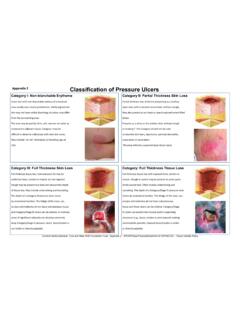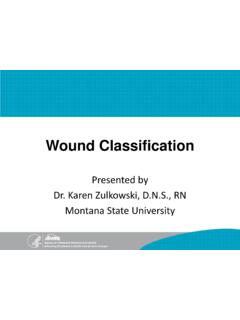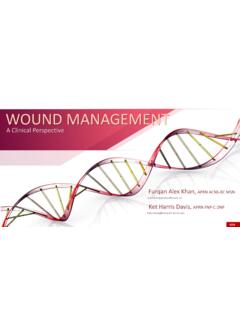Transcription of Medicare Coverage Policy ~ Decisions
1 Technology Assessment for pressure Reducing Therapy (Support Surfaces) Medicare Coverage Policy ~ DecisionsPressure Reducing Therapy (#CAG-00017N) (Support Surfaces)Technology AssessmentAir-Fluidized Beds Used forTreatment of pressure Ulcersin the Home Environment Health Care Technology AssessmentContract No. 290-97-0020 Task Order No. 06 November 7, 2001 Prepared by ECRI Agency for Healthcare Research and QualityCenter for Practice and Technology AssessmentRockville, MarylandExecutive SummaryThe purpose of this technology assessment is to determine the effectiveness of air-fluidized beds (a Group 3 support surface) and Group 2 support surfaces for the treatment of stage III and IV pressure ulcers in the home and other settings, and to compare the effectiveness of air-fluidized beds to Group 2 support surfaces. The Centers for Medicare and Medicaid Services (CMS) have divided support surfaces into three groups.
2 Air-fluidized beds are the only devices included in Group 3. Group 2 support surfaces include powered air flotation beds (low-air-loss therapy), powered pressure -reducing air mattresses (alternating air mattresses), and non-powered advanced pressure reducing mattresses, which can be placed directly over a hospital bed frame. Group 1 support surfaces are pressure pads, certain mattresses, and overlays for mattresses (foam, water, and gel mattresses).Current Medicare Policy reimburses for home use of air-fluidized beds only when the patient has stage III or IV pressure ulcers and only after the patient has completed at least a 30 day course of conservative treatment "without progression file:///F| (1 of 73) [5/17/2002 1:26:59 PM]Technology Assessment for pressure Reducing Therapy (Support Surfaces)toward wound healing." Medicare Policy states that conservative treatment must include "use of a specialized support surface (Group 2) designed to reduce pressure and shear forces on healing ulcers.
3 "This technology assessment was prepared in consideration of the interests of CMS. Hence, we consider the efficacy of support surfaces in the treatment of patients with pressure ulcers, but the role of specific support surfaces in preventing pressure ulcers is beyond the scope of this assessment. This assessment also emphasizes the use of air-fluidized beds in the home setting. In regards to this latter emphasis, we also examined use of Group 2 and 3 support surfaces in hospitals and nursing facilities for evidence of efficacy that might be transferable to the home setting. However, generalization of these data to the home setting is not straightforward because treatment of pressure ulcers typically involves a variety of procedures that are essential to proper healing, but are seldom completely reported in clinical studies of wound healing. Standard care for pressure ulcers usually includes pressure relief and skin protection to prevent progression of the ulcer to advanced stages, debridement of necrotic tissue in stage III and IV ulcers, wound cleansing, and dressings that promote a moist wound environment.
4 The similarities in the way these therapies are provided in the hospital or nursing facility to the way they are provided in the home is assessment addresses six questions:Question 1: Are air-fluidized beds effective in the treatment of stage III and/or IV pressure ulcers in the home setting? Of particular interest is evidence that the use of air-fluidized beds are superior to the use of Group 2 support surfaces for the healing of stage III and/or IV pressure randomized controlled trial (RCT) that compared the efficacy of air-fluidized beds to the efficacy of various conventional therapies in the home setting met the inclusion criteria for this question. However, a bias toward additional wound healing therapy (caused by the more aggressive wound care given to the air-fluidized beds group) renders this study's results difficult to interpret. Another RCT, performed in a hospital setting, provides some circumstantial evidence that air-fluidized beds could have some effectiveness in the home setting.
5 This study found that wound size reduction in larger ulcers, was significantly greater in patients on air-fluidized beds than in patients using alternating air mattresses. This study did not classify wounds according to stage , so the relevance of this finding to patients with stage III or IV ulcers cannot be precisely determined. Further, this study was performed more than 10 years ago and may not accurately reflect the effectiveness of Group 2 support surfaces as they are currently 2: Are Group 2 support surfaces effective in the treatment of stage III and/or IV pressure ulcers in the home setting?No studies that examined the efficacy of Group 2 support surfaces in the home setting met the inclusion criteria for this question. Therefore, a direct evidence-based answer to this question is not possible. Indirect evidence from three RCTs, conducted in hospitals or nursing homes, suggest that stage III and IV pressure ulcers progress towards healing on Group 2 support surfaces.
6 The findings of these three studies, however, are not conclusive, with none demonstrating statistically file:///F| (2 of 73) [5/17/2002 1:26:59 PM]Technology Assessment for pressure Reducing Therapy (Support Surfaces)significant differences between Group 2 support surfaces and foam mattresses in complete ulcer healing. The generalizability of the findings of these studies to the home setting is 3: At what stage of ulcer development should air-fluidized beds be used? Of particular interest is whether use of air-fluidized beds prevents transition from stage III to stage IV ulcers, and whether a 30-day waiting period (in which a stage III or IV pressure ulcer has not shown progression toward healing) before switching a patient to an air-fluidized bed is supported by clinical studies directly addressed this question, but one study provided indirect evidence suggesting that air-fluidized beds may be effective in preventing ulcer deterioration in at least some patients.
7 This study showed that 62% of patients with large ulcers (which are potentially stage III or IV) improved on air-fluidized beds and that 38% of patients with these ulcers showed no change or became Policy permits use of air-fluidized beds for the treatment of stage III and IV ulcers only after unsuccessful conservative treatment for 30 days. Data from three studies examining wound therapy other than Group 2 or 3 support surfaces indicate that although some patients will improve during 30 days of conservative treatment, other patients will not. The exact proportion of patients who do not improve during this period, however, is not known. Also unknown is the proportion of such patients who might benefit from earlier use of air-fluidized beds. Finally, the available clinical evidence is not sufficient to allow one to determine which type of patient will benefit from initial conservative treatment, and which type of patient will benefit when air-fluidized bed therapy is added to the conservative 4: What are the requirements (education, training, experience) needed for nursing or care giving in the home setting when using an air-fluidized bed?
8 No clinical studies were identified that reported on specific requirements for care in the home setting when using an air-fluidized bed. Consequently, we sought information from clinical guidelines, manuals, and review articles. Information on treatment protocols and patient safety in the use of air-fluidized beds were found in two guidelines written by the Office of Heath Technology Assessment (OHTA), and the University Hospital Consortium's Technology Advancement Center, and a user's manual for the Clinitron Hite-RiteTM air-fluidized bed. According to these sources, caregivers in the home setting need to be aware of the following potential difficulties and how to manage them: Patient dehydration Confusion due to the sensation of floating Accumulation of thick pulmonary secretions Knowledge of the control panel for turning on and off the blower that fluidizes the microsphere beads (needed to create a firm support surface for emergency CPR) Care of the microsphere beads and cleanup after leakage to protect patient and caregiver from skin irritation Bed elevation procedures Methods for turning patients in these beds file:///F| (3 of 73) [5/17/2002 1:26.]
9 59 PM]Technology Assessment for pressure Reducing Therapy (Support Surfaces)According to OHTA, appropriate home support is essential for optimizing the therapeutic benefits of air-fluidized beds and for preventing complications that may arise from a patient's limited mobility. To meet these needs, OHTA suggest that a specially trained nurse consultant provide training for the patient and 5: What are the requirements (education, training, experience) needed for nursing or care giving in the home setting when using Group 2 support surfaces?No clinical studies were identified that reported on the requirements (education, training, experience) needed for nursing or care giving in the home setting when using Group 2 support surfaces. As a consequence, we sought information from clinical guidelines, review articles, and manufacturer's manuals. Relevant information was found in guidelines written by the University Hospital Consortium's Technology Advancement Center, and the Support Surface Consensus Panel.
10 According to these sources, caregivers in the home setting need to be aware of the following issues: Proper maintenance of the support surface Cleaning the support surface to prevent the spread of infection Deflation for emergency procedures such as CPR Positioning of patients and turning schedule Flammability Need to avoid wrinkled sheets and kinked tubing Use incontinence pads without plastic backs Eliminating the use of skin protecting devices such as heel and elbow pads Absorbent breathable underpads should be used Question 6: What aspects of wound care constitute proper treatment of patients using air-fluidized beds or Group 2 Support Surfaces? Of particular interest are what types of dressings assist (or hamper) wound healing in patients using air-fluidized beds and what types of debridement assist (or hamper) wound healing in patients using air-fluidized beds?
















